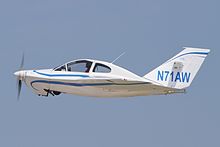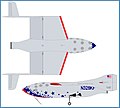Aircraft extremely low aspect ratio
An aircraft with an extremely low aspect ratio has a structural design in which wings with a relatively small span and a relatively large area are used. The aspect ratio is defined as the ratio of the squared wingspan to the wing area.
definition
There is no generally applicable definition for "extremely low aspect ratio" in the literature. However, a value of = 3 for low aspect ratio, = 5 to 6 for medium aspect ratio (6 to 10 for “ordinary” aircraft) and > 20 for high aspect ratio is given. “Very low” values, on the other hand, are used for the transonic and supersonic ranges. Aircraft of general aviation have a stretch 6 to 8
| Model | span | Wing area | Elongation |
|---|---|---|---|
| Handley Page HP.115 | 6.10 m | 39.95 m² | 0.9 |
| Chance Vought V-173 | 7.12 m | 39.67 m² | 1.3 |
| Arup S 2 | 5.80 m | 19.60 m² | 1.7 |
| Canova PC 100 | 5.90 m | 17.80 m² | 2.0 |
| Dyke JD-2 Delta | 6.87 m | 16.00 m² | 2.95 |
| Conventional aircraft | |||
| Cessna 172 | 10.97 m | 16.17 m² | 7.4 |
| Boeing 737 MAX | 35.92 m | 124.60 m² | 10.4 |
| Washer SF 25 C | 15.30 m | 18.20 m² | 13.4 |
Influence on aerodynamic efficiency
At low stretch and low speed, the induced drag dominates the "lift behavior". In slow flight aircraft, the induced drag accounts for more than 50% of the total drag. The extension of a wing is therefore a decisive parameter for the aerodynamic efficiency of an aircraft in the subsonic range. With the same wing area, wings with the greater aspect ratio have a higher efficiency in terms of lift. That is why the greatest possible aspect ratio is generally aimed for in the construction of aircraft. In supersonic this is not true, can be omitted here to a high elongation. An example of this is the delta wing , the X-15 or the F-104 .
In addition to the induced drag, the parasitic drag also contributes to the overall efficiency of a wing . The latter grows proportionally to the wing area. Aircraft with a low aspect ratio therefore have a high level of parasitic resistance in addition to a large induced drag. However, despite these disadvantages, there are certainly reasons to design a subsonic aircraft in this way.
Usually the reason for such constructions is flying with a very high angle of attack (= lift coefficient .) Aviation pioneers realized very early that the classic rhombus-shaped or hexagonal children's kite has a very high angle of attack on the rope and still generates a lot of lift. Many of these attempts were aimed at creating a completely stall-proof aircraft or one that can still be flown at a very high angle of attack. The diamond-shaped gliders of the Italian Flaminio Piana Canova are said to have reached up to 35 ° before the stall occurred. The same applies to the Suchanow disco plan and the Wainfan family's Facettomobile. Most of these constructions have in common that they do not have a conventional flow around the supporting surface, but a vortex system above the wing generates the necessary lift.
Applications
There were variants with a separate horizontal stabilizer, but the majority was designed without a tail . The Nemeth "Parasol" was a high-wing aircraft with a completely normal fuselage and a disc-shaped wing. Other applications for aircraft with extremely low aspect ratios such as William Horton's “Wingless” tended to be more in the direction of a flying car or a compact “people's plane”.
Still other designs were simply used to research the flow behavior of wings with extremely low aspect ratios, e.g. B. the Handley Page HP.115 . Last but not least, some attempts were aimed at finding out to what extent such aircraft are suitable as re-entry vehicles for space travel. The last stage of these considerations are the so-called lifting bodies .
Last but not least, the wish to have an absolutely unique flying device available for show purposes may have been the inspiration, as in the case of David Rowe. The Australian built a small circular plane called UFO (= Useless Flying Object) and is demonstrating it at flight days. Since 2015 it has a retractable landing gear, which reinforces the impression of a UFO .
For years, flying disks were popular in model aircraft construction, whereby the attached fin was often designed as a comic figure etc. Here they did not even bother to profile the "wing", but used a styrofoam plate with vertical edges that were reinforced with a surrounding wooden strip.
Graphic representations
Of the aircraft shown, only the Dyke JD2 was produced in larger numbers (~ 50). All the others remained unique.
Lee-Richards Annular Monoplane , England 1913
Arup S2 , USA 1932
Payen AP10a , France 1935
Fauvel AV10, France 1935
Canova PC 100, Italy 1934
Moskalev SAM-9, USSR 1937
Chance Vought V-173 , USA 1942
Sack AS-6 , Germany 1944
Handley Page HP. 115 1956
Dyke JD-2 Delta , USA 1964
Wainfan Facettomobile , USA 1993
Rutan Space Ship One , USA 2006
literature
- Rudolf Storck among others: Flying Wings . The historical development of the world's tailless and flying wing aircraft. Bernard and Graefe, Bonn 2003, ISBN 3-7637-6242-6 .
- Vincenzo Pedrielli, Francesco Camastra: Italian Vintage Sailplanes. EQIP Werbung & Verlag GmbH, Königswinter 2011, ISBN 978-3-9808838-9-4 , pp. 198f
Individual evidence
- ^ AC Kermode: Mechanics of Flight , Pearson, 12th edition 2012, pp. 97 and 100
- ^ David F. Anderson, Scott Eberhardt: Understanding Flight , McGraw Hill, 2nd edition 2010, p. 267
Web links
- Eshelman Flying Flounder and Horton Swoopy on video
- Rowe "UFo" on video
- Arup S2 on video
- Vought V-173 on video


































